The Vengeance of Ivarr the Boneless
Did he, and other Vikings, really use a brutal method of ritual execution called the “blood eagle”?
![]()
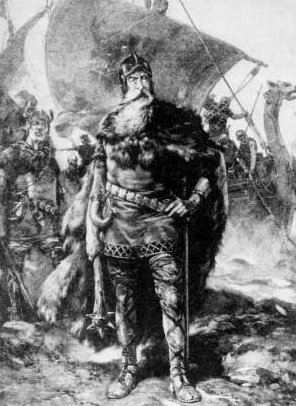
Vikings as portrayed in a 19th-century source: fearsome warriors and sea raiders.
Ninth-century Scandinavia has had good press in recent years. As late as the 1950s, when Kirk Douglas filmed his notorious clunker The Vikings—a movie that featured lashings of fire and pillage, not to mention Tony Curtis clad in an ahistorical and buttocks-skimming leather jerkin—most popular histories still cast the Denmark and Norway of the Dark Ages as nations overflowing with bloodthirsty warriors who were much given to horned helmets and drunken ax-throwing contests. If they weren’t worshiping the pagan gods of Asgard, these Vikings were sailing their longships up rivers to sack monasteries while ravishing virgins and working themselves into berserker rages.
Since the early 1960s, though—we can date the beginning of the change to the publication of Peter Sawyer’s influential The Age of the Vikings (1962)—rehabilitation has been almost complete. Today, the early Viking age has become the subject of a History Channel drama, and historians are likely to stress that the Vikings were traders and settlers, not rapists and killers. The Scandinavians’ achievements have been lauded—they sailed all the way to America and produced the Lewis Chessmen—and nowadays some scholars go so far as to portray them as agents of economic stimulus, occasional victims of their more numerous enemies, or even (as a recent campaign organized by the University of Cambridge suggested) men who “preferred male grooming to pillaging,” carrying around ear spoons to remove surplus wax. To quote the archaeologist Francis Pryor, they “integrated into community life” and “joined the property-owning classes” in the countries they invaded.
Much of this is, of course, necessary revisionism. The Vikings did build a civilization, did farm and could work metal. But, as the medievalist Jonathan Jarrett notes, the historical evidence also shows that they took thousands of slaves and deserved their reputation as much-feared warriors and mercenaries. They could be greedy and implacable foes, and over the centuries reduced several strong and wealthy kingdoms (not least Anglo-Saxon England) to the point of collapse. Much of the time, moreover, the same men who were doing the farming and the metalworking were also responsible for the raping and looting—it was a matter of economic imperative that Vikings who planted crops in the poor soil of Norway, Orkney or northern Scotland in the spring went raiding in the summer before returning home at harvest-time. Finally, as Jarrett points out, being a well-groomed but brutal soldier is scarcely a contradiction in terms. One of the Viking fighters killed at the Battle of Stamford Bridge in 1066 gloried in the nickname of Olaf the Flashy, and “the era that invented and lauds James Bond really shouldn’t need telling that someone can plausibly be all of heroic, well-dressed and pathologically violent.”
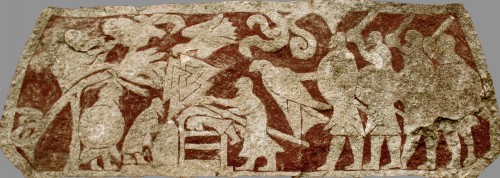
A section from the Stora Hammars I stone, preserved at Gotland in Sweden. The carving seems to show a victim about to be cut open from the back; a bird of prey appears behind him. It has been suggested that this depicts the rite of the blood eagle. Image: Wikicommons.
There have always been problems, in short, for historians who want to suggest that the Vikings were peace-loving and misunderstood, and of these the most intractable is their penchant—at least as portrayed in chronicles and sagas—for gory ritual killings. Among several eminent victims of this practice, we might number the Saxon king Edmund the Martyr—who died in 869, tied to a tree (says the 10th-century Passio Sancti Eadmundi), thoroughly scourged and then used for target practice by Danish archers “until he was all covered with their missiles as with bristles of a hedgehog”—and Ælla, king of Northumbria, who in 867 is said to have met an even more unpleasant fate at Viking hands in a rite known as the “blood eagle.”
One does not have to search too far in the secondary sources to uncover explicit descriptions of what execution by the blood eagle entailed. At its most elaborate, sketched by Sharon Turner in the History of the Anglo-Saxons (1799) or J.M. Lappenberg in his History of England Under the Anglo-Saxon Kings (1834), the ritual involved several distinct stages. First the intended victim would be restrained, face down; next, the shape of an eagle with outstretched wings would be cut into his back. After that, his ribs would be hacked from his spine with an ax, one by one, and the bones and skin on both sides pulled outward to create a pair of “wings” from the man’s back. The victim, it is said, would still be alive at this point to experience the agony of what Turner terms “saline stimulant”—having salt rubbed, quite literally, into his vast wound. After that, his exposed lungs would be pulled out of his body and spread over his “wings,” offering witnesses the sight of a final bird-like “fluttering” as he died.
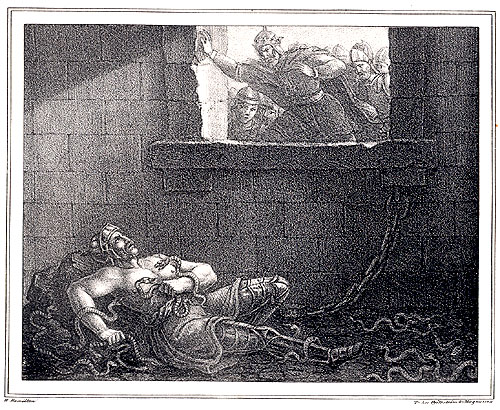
Ragnar Hairy Breeches meets his end in King Ælla’s pit of vipers. From Hugo Hamilton, Teckningar ur Skandinaviens Äldre Historia (Stockholm 1830). Image: Wikicommons.
Well into the last century, most historians of the Vikings accepted that the blood eagle was deeply unpleasant but very real. According to the eminent medievalist J.M. Wallace-Hadrill, its possible victims were not only Ælla of Northumbria but also Halfdán, the son of Harald Finehair, king of Norway, and the Irish King Maelgualai of Munster; in some interpretations, it is supposed that even Edmund the Martyr may have suffered the same fate.
To put these claims in context, it is necessary to note that each of these tormented royals died late in the ninth century or early in the 10th, and that two of them—Ælla and Edmund—were killed by Ivarr the Boneless, the most feared Viking of that day. Ivarr, in turn, was the son of the equally notorious (if marginally historical) Ragnarr Loðbrók, whose name translates as “Ragnar Hairy Breeches.” Ragnarr is supposed to have been the Viking who sacked Paris in 845, and—at least according to the medieval Icelandic Þáttr af Ragnars sonum (Tale of Ragnar’s Sons)—he eventually met his end after being shipwrecked on the coast of the northern Anglo-Saxon kingdom of Northumbria. Captured by the local ruler, he was killed by being hurled into a pit of vipers.
It is only when this background is understood that the horrible death ascribed to Ælla makes much sense, because Ælla was the king who captured Ragnarr Loðbrók. By carving the blood eagle into Ælla’s back, Ivarr was avenging his father’s killing; what’s more, Viking fury at Ragnarr’s death might also explain the appearance of the Danes’ Great Army in England at about this time. Since that army and its depredations proved to be the motor of some of the most vital episodes in Anglo-Saxon history—not least the rise and eventual triumph of King Alfred the Great—it is not surprising that many eminent scholars have accepted the historical reality of what Patrick Wormald termed this “ferocious sacrificial ritual.”
Perhaps the most prominent proponent of the blood eagle as a real ritual has been Alfred Smyth, the controversial Irish specialist in the history of Scandinavian kings in the British Isles during the ninth century. For Smyth, while King Ælla’s Northumbrian snake pit was a mere literary figment (a sensible conclusion, it must be said, given the scarcity of poisonous snakes in England),
it is difficult to believe that the details of this butchery were invented by a later medieval Norwegian compiler… the details explain precisely what the blood-eagle was all about … the fact that the term bloðorn existed as a meaningful concept in the Old Norse vocabulary indicates that it constituted a ritual form of slaying in its own right.
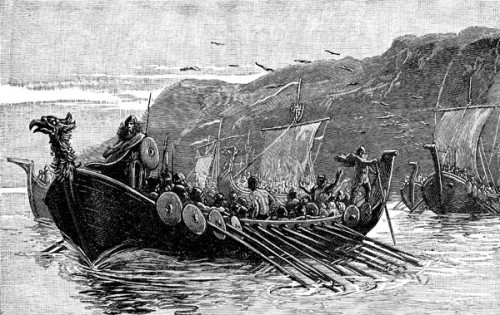
One key to the success of the Viking raiders of this period was their maneuverability. Shallow-draft longships allowed them to penetrate river systems and disappear at will.
In support of this thesis, Smyth cites the Orkneyinga Saga—a late-12th-century Icelandic account of the Earls of Orkney, in which another well-known Viking leader, Earl Torf-Einar, carves the blood eagle into the back of his enemy Halfdán Long-legs “by laying his sword in the hollow at the backbone and hacking all his ribs from the backbone down to the loins, and drawing out the lungs.” Smyth goes on to suggest that both Halfdán and Ælla were sacrifices to the Norse gods: “The sacrifice for victory,” he notes, “was a central feature of the cult of Oðinn .”
That there are some problems with these claims will not surprise anyone who has studied this period of history; sources for the ninth- and 10th-century Scandinavian world are few, mostly late and open to interpretation. Smyth’s identifications of several victims of the blood eagle ritual are certainly subject to challenge. Alex Woolf, the author of the latest general history of Scotland in the period covered by Orkneyinga Saga, bluntly concludes that it is a work of literature, not history, for the period to 1100, while the fate of Maelgualai of Munster is known only from annals composed centuries later. Maelgualai is said by the Cogadh Gaedhel re Gallaibh (the Wars of the Irish with the Foreigners, composed as late as the 12th century) to have died in 859 when “his back was broken on a stone”—an act that Smyth insists implies a ritual murder that “recalls the blood-eagle procedure.” But the account given in another old Irish chronicle, the Annals of the Four Masters–which reports merely that Maelgualai “was stoned by the Norsemen until they slew him”–is equally credible.
So accounts of the blood eagle are generally rather late–most are 12th- or 13th-century–and rather worryingly based on the evidence of Norse and Icelandic sagas, which were written by poets and designed to be recited as entertainment during the long northern winters. The sagas tell great stories, which makes them deeply enticing to historians struggling with the fragmentary evidence for this fascinating period, but since it is hard to reconcile them with contemporary chronicles, they have become considerably less fashionable than they once were as sources of serious history. Moreover, if Halfdán Long-legs and Maelgualai are crossed off the list of those who suffered death by the blood eagle—and if we pass over the entirely unproven suggestion that Edmund the Martyr may have been hacked to death with axes rather than shot to death with arrows (or, as the Anglo-Saxon Chronicle implies, simply killed in battle)—we are left with only King Ælla as a possible victim of this form of ritual execution.
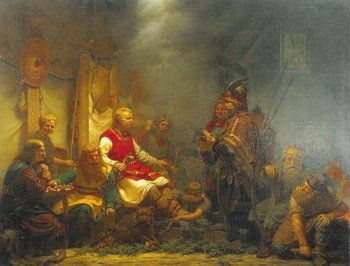
Johan August Malmstrom’s 1857 painting King Ælla’s Messenger Before Ragnar Lodbrok’s Sons depicts the arrival of the news of Loðbrók’s death at the Danish court.
Here it is necessary to turn to a paper published by Roberta Frank some 30 years ago in the august English Historical Review. Frank– a scholar of Old English and Scandinavian literature who was then at the University of Toronto, but is now at Yale—not only discusses the original source for the story of King Ælla’s death, but also makes the important point that “the blood eagling procedure varies from text to text, becoming more lurid, pagan and time-consuming with each passing century.” The earliest sources, she stresses–such as the Danish historian Saxo Grammaticus–
merely envisage someone scratching, as deeply as possible, a picture of an eagle upon Ella’s back…. Orkneyinga Saga envisages the tearing out of ribs and lungs and provides the information that the rite was intended as a sacrifice to Oðinn…. the late Þáttr af Ragnars sonum gives a full, sensational report of the event… by the beginning of the 19th century, the various sagas’ motifs—eagle sketch, rib division, lung surgery, and ‘saline stimulant’—were combined in inventive sequences designed for maximum horror.
It may seem to be a pretty tall order to arrive at any sort of judgement on this scholarly debate, but one of the joys of studying such an obscure period of history is that the sources are so scant that anyone can become familiar with them. For me, Frank scores most heavily by pointing out that (if the late Icelandic sagas are discarded as evidence, as they surely must be) what remains is nothing but one early-11th-century half-stanza of skaldic verse that formed part of a now-fragmentary series of poems known as the Knútsdrápa because they are thought to have been composed to be read to King Canute. This reads
Ok Ellu bak,
at lét hinn’s sat,
Ívarr, ara,
Iorvik, skorit
and translates, literally but enigmatically, as
And Ella’s back,
at had the one who dwelt,
Ívarr, with eagle,
York, cut.
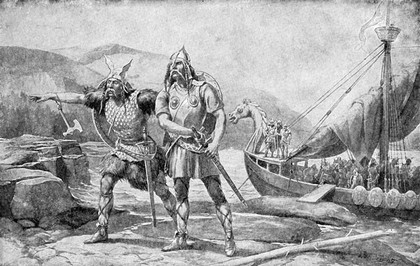
A Viking landing on a hostile coast, as depicted in a history from the Victorian era.
Frank goes on to a learned discussion of the Norse love of gnomic poetry and of how these lines may best be translated—much depends, apparently, on the instrumental force of the ablative. Her view, though, is clearly stated: “An experienced reader of skaldic poetry, looking at stanza in isolation from its saga context, would have trouble seeing it as anything but a conventional utterance, an allusion to the eagle as a carrion beast, the pale bird with red claws perched on and slashing the back of the slain: ‘Ívarr had Ella’s back scored by an eagle.’ ” And the image of an eagle’s claws, she concludes, is conventionally paired with the suffering of martyrs in texts written by Christian scribes throughout late antiquity and the early medieval period.
The crucial point, though, is made elsewhere in Franks’ paper, in a passage that points out that, in those few obscure words of verse, “the syntax, in addition to being skewed, is ambiguous; yet every trace of ambiguity has disappeared from the version of the stanza accepted by modern editors.” Which is to say that the rite of the blood eagle is, and always has been, a matter of interpretation, one that has as much substance as Tony Curtis’ buttocks-skimming jerkin.
Seen from that perspective, it’s no surprise that—at least so long as scholars remain intent on recasting the Vikings as farmers with a penchant for the occasional fight—we’ll be encouraged to doubt the reality of the blood eagle. When the wheel turns, though, as it most probably will, don’t be too surprised to hear historians once again contending that blood-drenched Scandinavians sacrificed victims to their pagan gods.
***
Sign up for our free email newsletter and receive the best stories from Smithsonian.com each week.
Sources
Guðbrandur Vigfússon and F. York Powell. Corpus Poeticum Boreale: The Poetry of the Old Northern Tongue from the Earliest Times to the Thirteenth century. Oxford: Clarendon Press, 1883; Clare Downham. Viking Kings of Britain and Ireland: The Dynasty of Ívarr to A.D. 1014. Edinburgh: Dunedin Academic Press, 2008; Roberta Frank. ‘Viking atrocity and Skaldic verse: the rite of the Blood Eagle.’ English Historical Review XCIX (1984); Guy Halsall. Warfare and Society in the Barbarian West, 450-900. New York: Routledge, 2003; Hermann Pálsson (ed.). Orkneyinga Saga. London: Penguin, 1981; Alfred Smyth. Scandinavian Kings in the British Isles, 850-880. Oxford: Oxford University Press, 1977; Alex Woolf. From Pictland to Alba: Scotland 789-1070. Edinburgh. Edinburgh University Press, 2007.
/https://tf-cmsv2-smithsonianmag-media.s3.amazonaws.com/accounts/headshot/mike-dash-240.jpg)
/https://tf-cmsv2-smithsonianmag-media.s3.amazonaws.com/accounts/headshot/mike-dash-240.jpg)